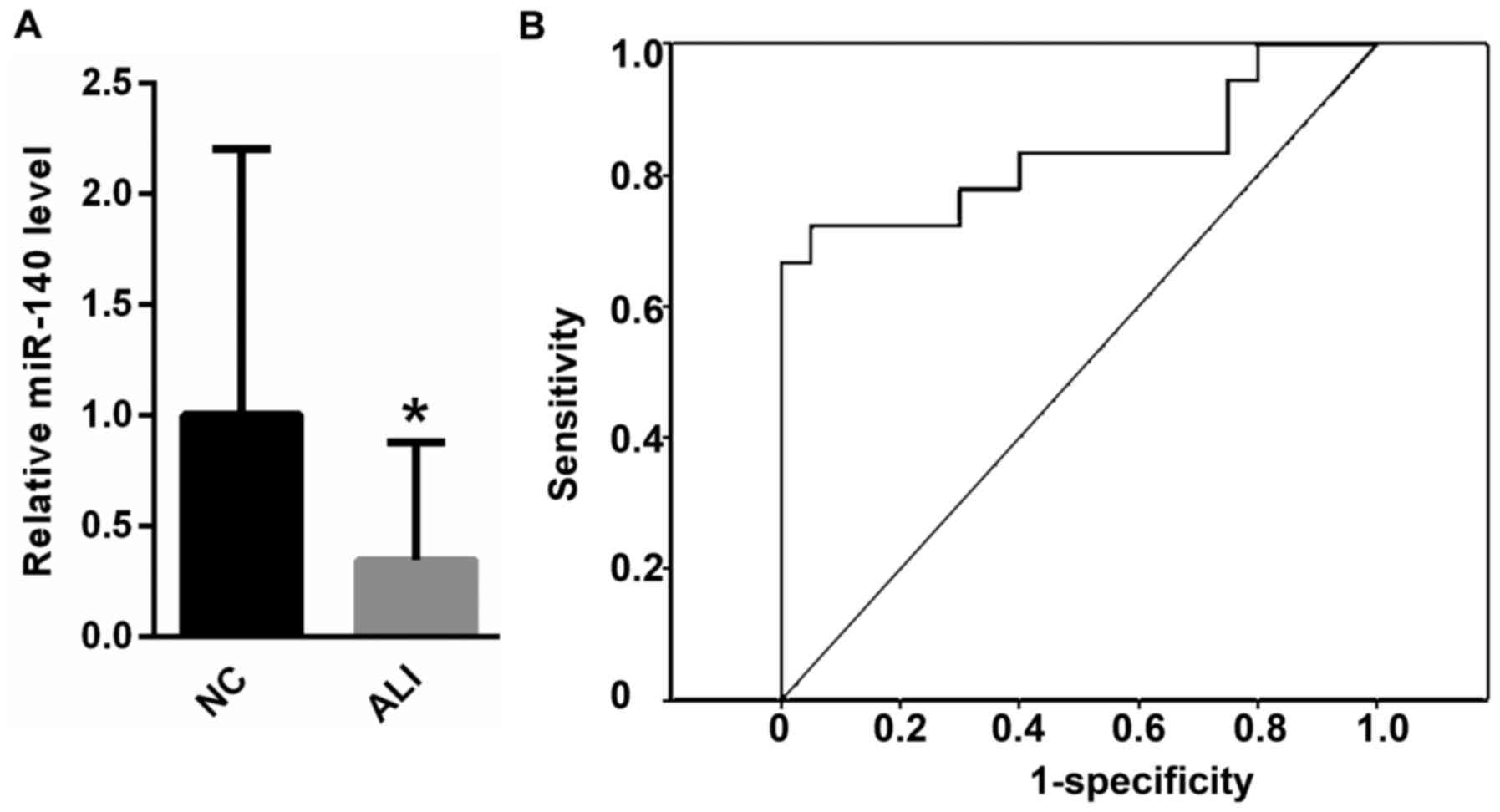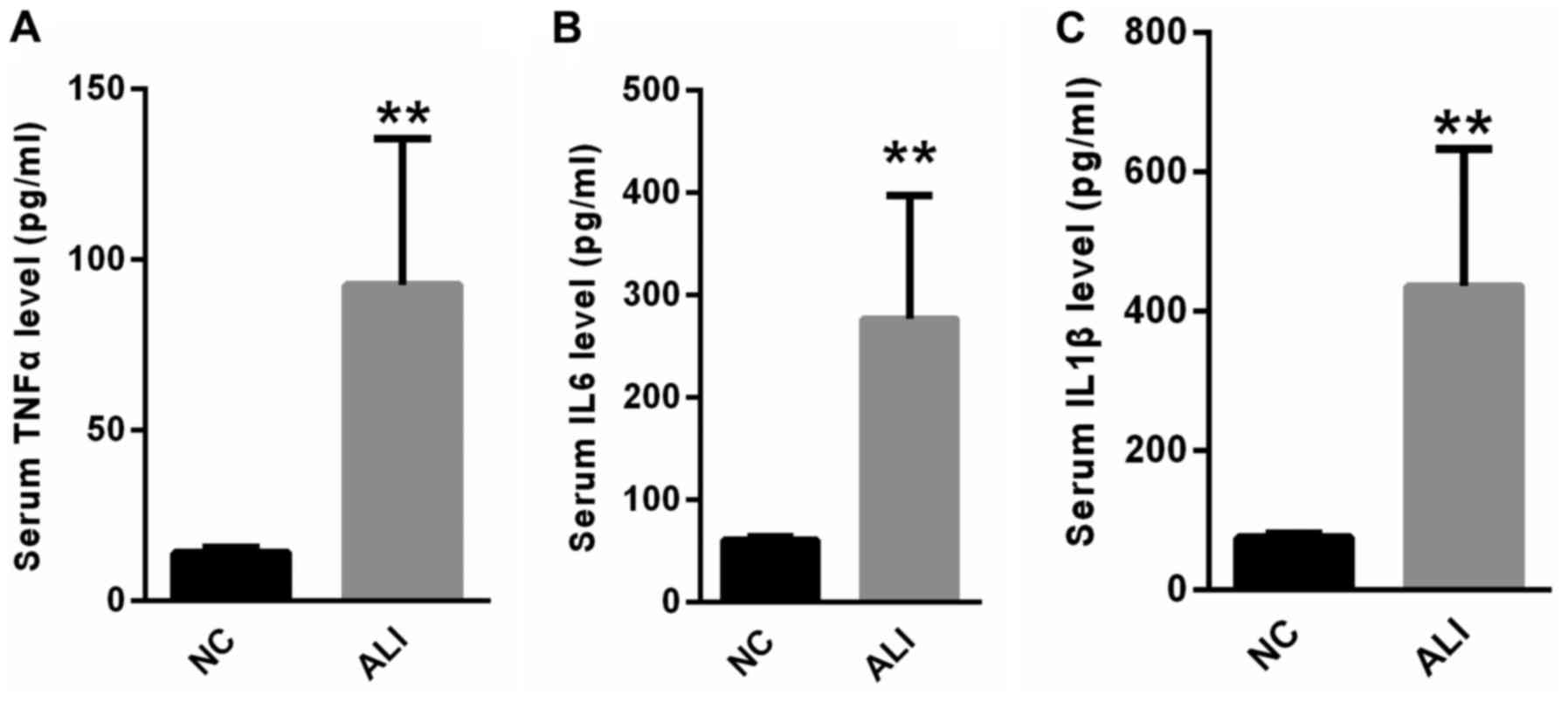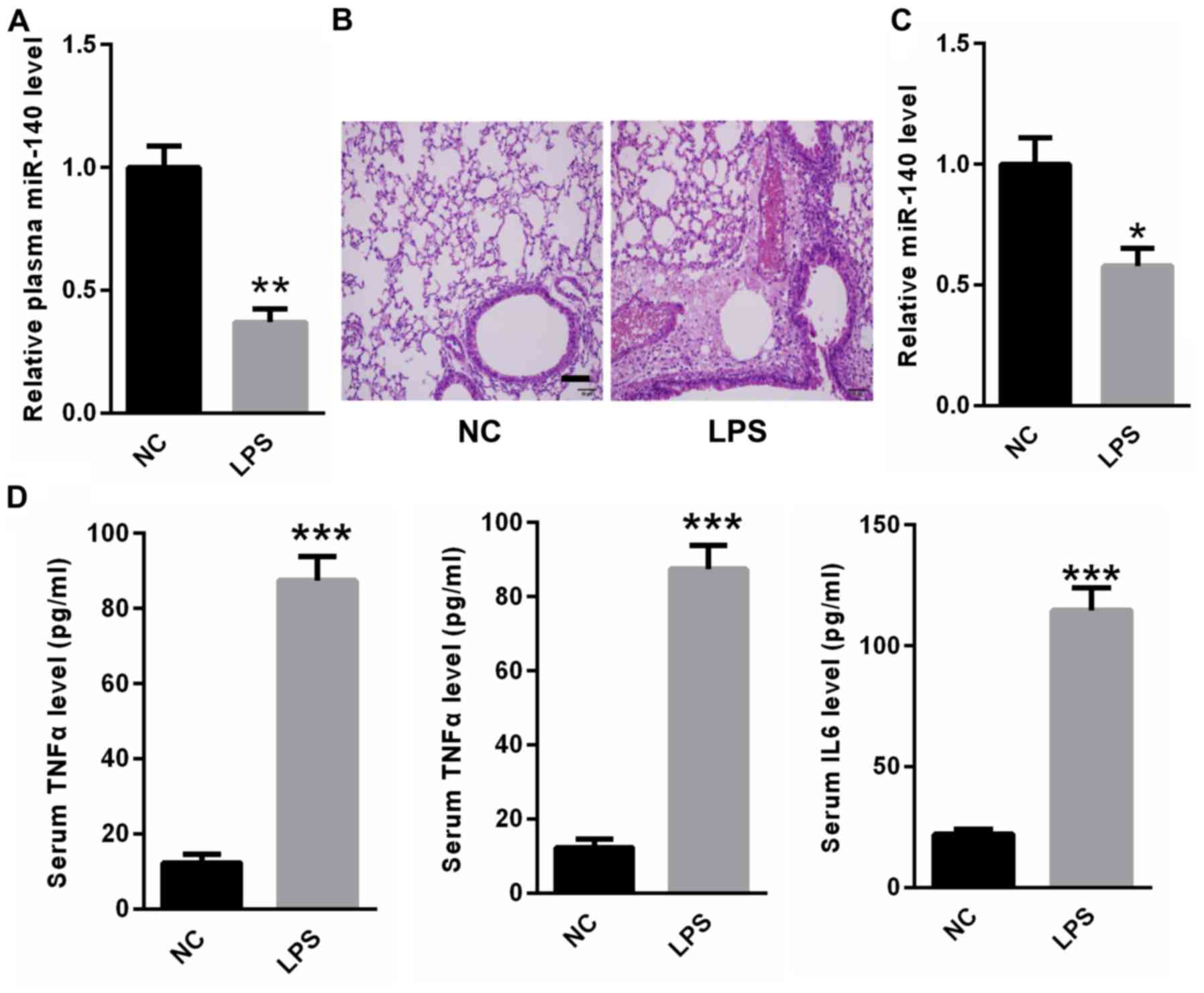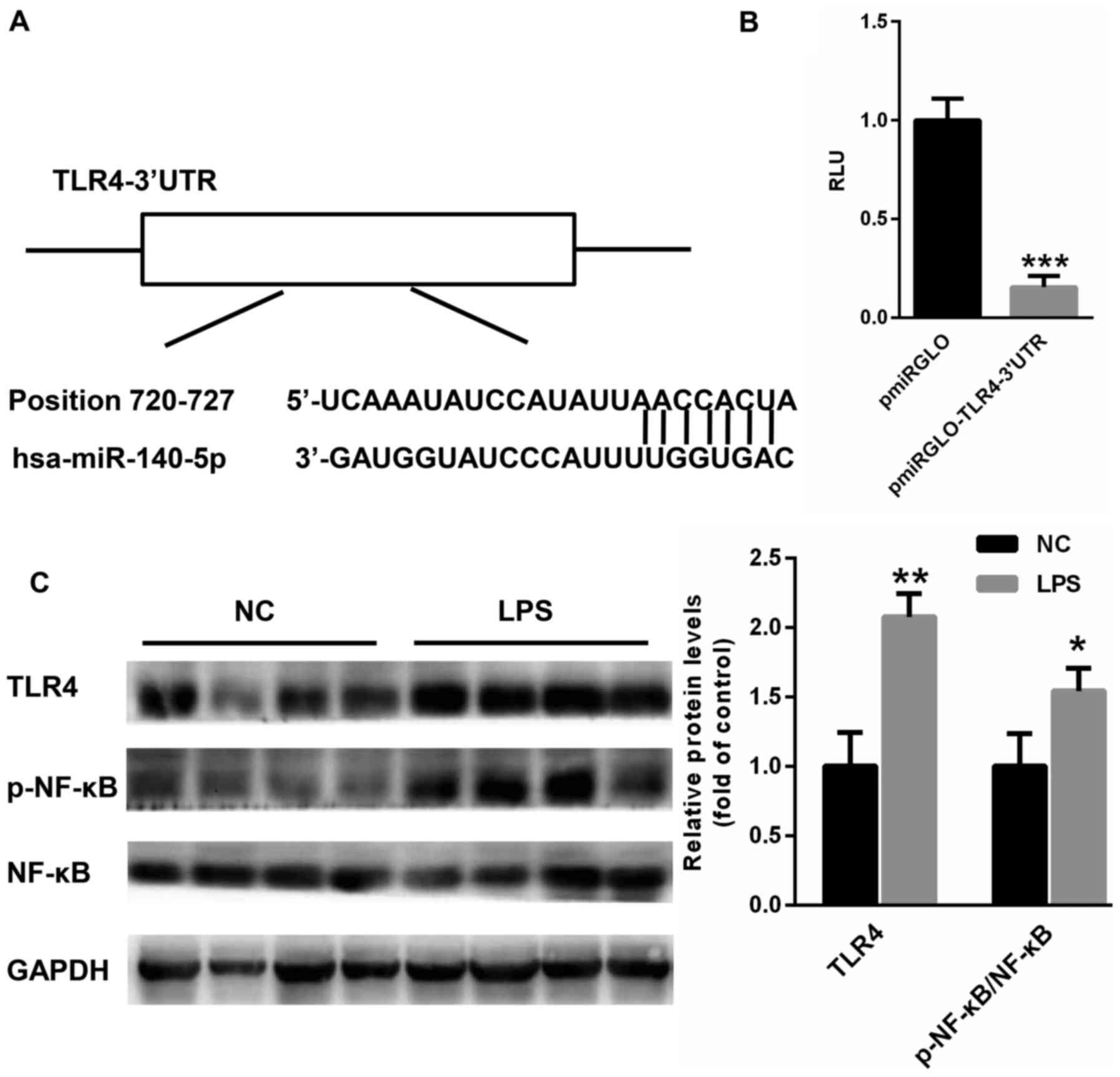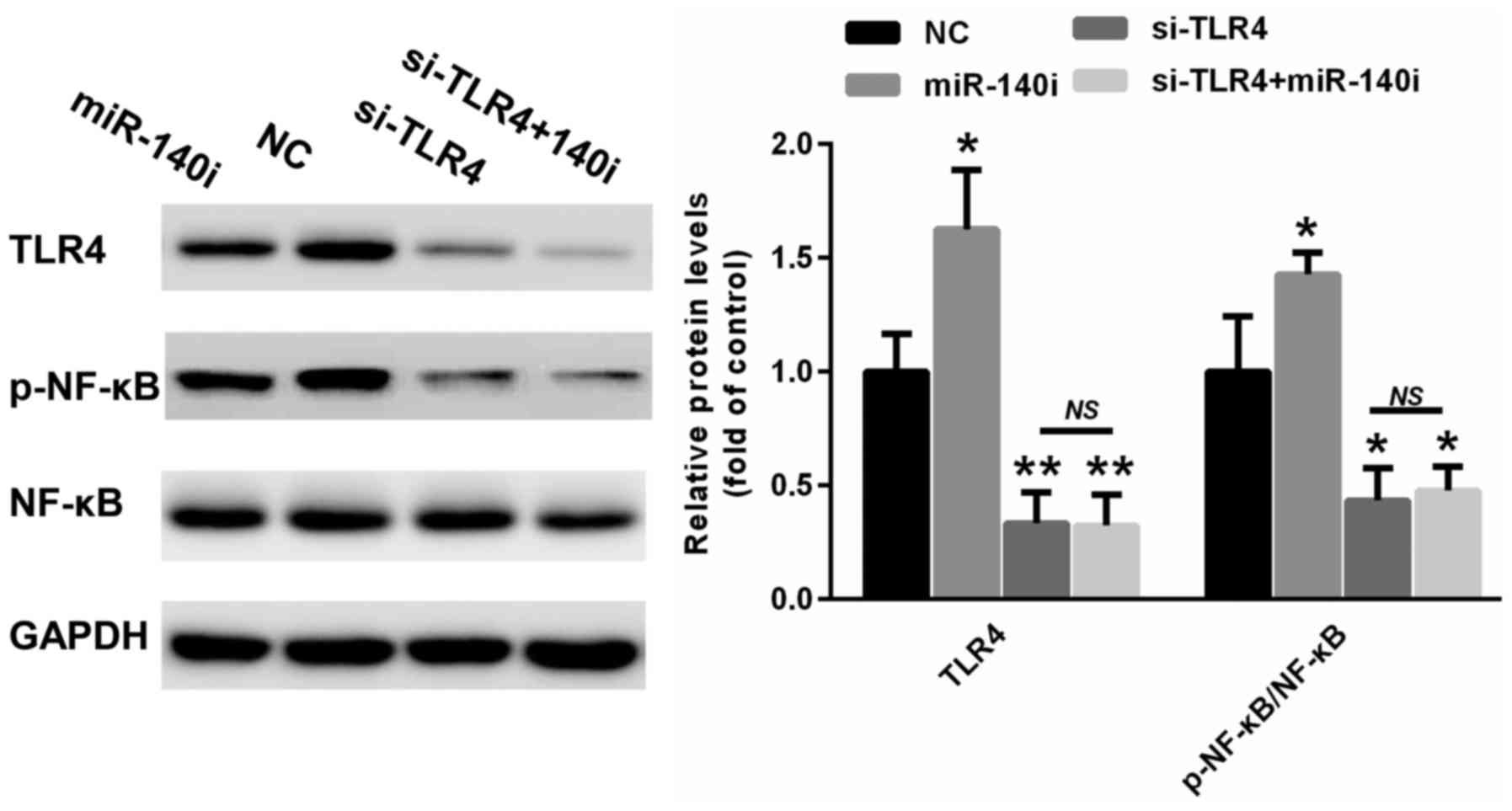|
1
|
Deng J, Wang DX, Liang AL, Tang J and
Xiang DK: Effects of baicalin on alveolar fluid clearance and
α-ENaC expression in rats with LPS-induced acute lung injury. Can J
Physiol Pharmacol. 95:122–128. 2017. View Article : Google Scholar : PubMed/NCBI
|
|
2
|
Fragoso IT, Ribeiro EL, Gomes FO, Donato
MA, Silva AK, Oliveira AC, Araújo SM, Barbosa KP, Santos LA and
Peixoto CA: Diethylcarbamazine attenuates LPS-induced acute lung
injury in mice by apoptosis of inflammatory cells. Pharmacol Rep.
69:81–89. 2017. View Article : Google Scholar : PubMed/NCBI
|
|
3
|
Hsia TC and Yin MC: Post-intake of S-ethyl
cysteine and S-methyl cysteine improved LPS-induced acute lung
injury in mice. Nutrients. 8:pii: E5072016. View Article : Google Scholar
|
|
4
|
Hu Y, Lou J, Mao YY, Lai TW, Liu LY, Zhu
C, Zhang C, Liu J, Li YY, Zhang F, et al: Activation of MTOR in
pulmonary epithelium promotes LPS-induced acute lung injury.
Autophagy. 12:2286–2299. 2016. View Article : Google Scholar : PubMed/NCBI
|
|
5
|
Huang WC, Lai CL, Liang YT, Hung HC, Liu
HC and Liou CJ: Phloretin attenuates LPS-induced acute lung injury
in mice via modulation of the NF-κB and MAPK pathways. Int
Immunopharmacol. 40:98–105. 2016. View Article : Google Scholar : PubMed/NCBI
|
|
6
|
Jang YJ, Back MJ, Fu Z, Lee JH, Won JH, Ha
HC, Lee HK, Jang JM, Choi JM and Kim DK: Protective effect of
sesquiterpene lactone parthenolide on LPS-induced acute lung
injury. Arch Pharm Res. 39:1716–1725. 2016. View Article : Google Scholar : PubMed/NCBI
|
|
7
|
Kim J, Jeong SW, Quan H, Jeong CW, Choi JI
and Bae HB: Effect of curcumin (Curcuma longa extract) on
LPS-induced acute lung injury is mediated by the activation of
AMPK. J Anesth. 30:100–108. 2016. View Article : Google Scholar : PubMed/NCBI
|
|
8
|
Jiang L, Zhang L, Kang K, Fei D, Gong R,
Cao Y, Pan S and Zhao M and Zhao M: Resveratrol ameliorates
LPS-induced acute lung injury via NLRP3 inflammasome modulation.
Biomed Pharmacother. 84:130–138. 2016. View Article : Google Scholar : PubMed/NCBI
|
|
9
|
Li W, Qiu X, Jiang H, Han Y, Wei D and Liu
J: Downregulation of miR-181a protects mice from LPS-induced acute
lung injury by targeting Bcl-2. Biomed Pharmacother. 84:1375–1382.
2016. View Article : Google Scholar : PubMed/NCBI
|
|
10
|
Zhou Z and You Z: Mesenchymal stem cells
alleviate LPS-induced acute lung injury in mice by
MiR-142a-5p-controlled pulmonary endothelial cell autophagy. Cell
Physiol Biochem. 38:258–266. 2016. View Article : Google Scholar : PubMed/NCBI
|
|
11
|
Tao Z, Yuan Y and Liao Q: Alleviation of
lipopolysaccharides-induced acute lung injury by MiR-454. Cell
Physiol Biochem. 38:65–74. 2016. View Article : Google Scholar : PubMed/NCBI
|
|
12
|
Xiao J, Tang J, Chen Q, Tang D, Liu M, Luo
M, Wang Y, Wang J, Zhao Z, Tang C, et al: miR-429 regulates
alveolar macrophage inflammatory cytokine production and is
involved in LPS-induced acute lung injury. Biochem J. 471:281–291.
2015. View Article : Google Scholar : PubMed/NCBI
|
|
13
|
Bao H, Gao F, Xie G and Liu Z:
Angiotensin-converting enzyme 2 inhibits apoptosis of pulmonary
endothelial cells during acute lung injury through suppressing
MiR-4262. Cell Physiol Biochem. 37:759–767. 2015. View Article : Google Scholar : PubMed/NCBI
|
|
14
|
Syed M, Das P, Pawar A, Aghai ZH, Kaskinen
A, Zhuang ZW, Ambalavanan N, Pryhuber G, Andersson S and Bhandari
V: Hyperoxia causes miR-34a-mediated injury via angiopoietin-1 in
neonatal lungs. Nat Commun. 8:11732017. View Article : Google Scholar : PubMed/NCBI
|
|
15
|
Liu Q, Du J, Yu X, Xu J, Huang F, Li X,
Zhang C, Li X, Chang J, Shang D, et al: miRNA-200c-3p is crucial in
acute respiratory distress syndrome. Cell Discov. 3:170212017.
View Article : Google Scholar : PubMed/NCBI
|
|
16
|
Wu X, Xia M, Chen D, Wu F, Lv Z, Zhan Q,
Jiao Y, Wang W, Chen G and An F: Profiling of downregulated
blood-circulating miR-150-5p as a novel tumor marker for
cholangiocarcinoma. Tumour Biol. 37:15019–15029. 2016. View Article : Google Scholar : PubMed/NCBI
|
|
17
|
Huang Y, Tang S, Ji-Yan C, Huang C, Li J,
Cai AP and Feng YQ: Circulating miR-92a expression level in
patients with essential hypertension: A potential marker of
atherosclerosis. J Hum Hypertens. 31:200–205. 2017. View Article : Google Scholar : PubMed/NCBI
|
|
18
|
Coskunpinar E, Cakmak HA, Kalkan AK,
Tiryakioglu NO, Erturk M and Ongen Z: Circulating miR-221-3p as a
novel marker for early prediction of acute myocardial infarction.
Gene. 591:90–96. 2016. View Article : Google Scholar : PubMed/NCBI
|
|
19
|
Yuan R, Wang G, Xu Z, Zhao H, Chen H, Han
Y, Wang B, Zhou J, Hu H, Guo Z, et al: Up-regulated circulating
miR-106a by DNA methylation promised a potential diagnostic and
prognostic marker for gastric cancer. Anticancer Agents Med Chem.
16:1093–1100. 2016. View Article : Google Scholar : PubMed/NCBI
|
|
20
|
Han Y, Li Y and Jiang Y: The prognostic
value of plasma MicroRNA-155 and MicroRNA-146a level in severe
sepsis and sepsis-induced acute lung injury patients. Clin Lab.
62:2355–2360. 2016. View Article : Google Scholar : PubMed/NCBI
|
|
21
|
Cui Y, Yi L, Zhao JZ and Jiang YG: Long
noncoding RNA HOXA11-AS functions as miRNA sponge to promote the
glioma tumorigenesis through targeting miR-140-5p. DNA Cell Biol.
36:822–828. 2017. View Article : Google Scholar : PubMed/NCBI
|
|
22
|
Fang Z, Yin S, Sun R, Zhang S, Fu M, Wu Y,
Zhang T, Khaliq J and Li Y: miR-140-5p suppresses the
proliferation, migration and invasion of gastric cancer by
regulating YES1. Mol Cancer. 16:1392017. View Article : Google Scholar : PubMed/NCBI
|
|
23
|
Sun Z, Zhou D, Xie X, Wang S, Wang Z, Zhao
W, Xu H and Zheng L: Cross-talk between macrophages and atrial
myocytes in atrial fibrillation. Basic Res Cardiol. 111:632016.
View Article : Google Scholar : PubMed/NCBI
|
|
24
|
Livak KJ and Schmittgen TD: Analysis of
relative gene expression data using real-time quantitative PCR and
the 2(-Delta Delta C(T)) method. Methods. 25:402–408. 2001.
View Article : Google Scholar : PubMed/NCBI
|
|
25
|
Carvalho JL, Britto A, de Oliveira AP,
Castro-Faria-Neto H, Albertini R, Anatriello E and Aimbire F:
Beneficial effect of low-level laser therapy in acute lung injury
after i-I/R is dependent on the secretion of IL-10 and independent
of the TLR/MyD88 signaling. Lasers Med Sci. 32:305–315. 2017.
View Article : Google Scholar : PubMed/NCBI
|
|
26
|
Xu C, Chen G, Yang W, Xu Y, Xu Y, Huang X,
Liu J, Feng Y, Xu Y and Liu B: Hyaluronan ameliorates LPS-induced
acute lung injury in mice via Toll-like receptor (TLR) 4-dependent
signaling pathways. Int immunopharmacol. 28:1050–1058. 2015.
View Article : Google Scholar : PubMed/NCBI
|
|
27
|
Chen C, Wang YL, Wang CY and Zhang ZZ:
Effect of TLR-4 and HO-1 on acute lung injury induced by
hemorrhagic shock in mice. Chin J Traumatol. 11:78–83. 2008.
View Article : Google Scholar : PubMed/NCBI
|
|
28
|
Cabrera-Perez J, Babcock JC, Dileepan T,
Murphy KA, Kucaba TA, Badovinac VP and Griffith TS: Gut microbial
membership modulates CD4 T cell reconstitution and function after
sepsis. J Immunol. 197:1692–1698. 2016. View Article : Google Scholar : PubMed/NCBI
|
|
29
|
Barsness KA, Arcaroli J, Harken AH,
Abraham E, Banerjee A, Reznikov L and McIntyre RC:
Hemorrhage-induced acute lung injury is TLR-4 dependent. Am J
Physiol Regul Integr Comp Physiol. 287:R592–R599. 2004. View Article : Google Scholar : PubMed/NCBI
|
|
30
|
Sodhi CP, Jia H, Yamaguchi Y, Lu P, Good
M, Egan C, Ozolek J, Zhu X, Billiar TR and Hackam DJ: Intestinal
epithelial TLR-4 activation is required for the development of
acute lung injury after trauma/hemorrhagic shock via the release of
HMGB1 from the gut. J Immunol. 194:4931–4939. 2015. View Article : Google Scholar : PubMed/NCBI
|
|
31
|
Tianzhu Z and Shumin W: Esculin inhibits
the inflammation of LPS-induced acute lung injury in mice via
regulation of TLR/NF-κB pathways. Inflammation. 38:1529–1536. 2015.
View Article : Google Scholar : PubMed/NCBI
|
|
32
|
Wang CC, Yuan JR, Wang CF, Yang N, Chen J,
Liu D, Song J, Feng L, Tan XB and Jia XB: Anti-inflammatory effects
of phyllanthus emblica L on benzopyrene-induced precancerous lung
lesion by regulating the IL-1β/miR-101/Lin28B signaling pathway.
Integr Cancer Ther. 16:505–515. 2017. View Article : Google Scholar : PubMed/NCBI
|
|
33
|
Arroyo JD, Chevillet JR, Kroh EM, Ruf IK,
Pritchard CC, Gibson DF, Mitchell PS, Bennett CF,
Pogosova-Agadjanyan EL, Stirewalt DL, et al: Argonaute2 complexes
carry a population of circulating microRNAs independent of vesicles
in human plasma. Proc Natl Acad Sci USA. 108:5003–5008. 2011.
View Article : Google Scholar : PubMed/NCBI
|
|
34
|
Kroh EM, Parkin RK, Mitchell PS and Tewari
M: Analysis of circulating microRNA biomarkers in plasma and serum
using quantitative reverse transcription-PCR (qRT-PCR). Methods.
50:298–301. 2010. View Article : Google Scholar : PubMed/NCBI
|
|
35
|
Jiang K, Guo S, Zhang T, Yang Y, Zhao G,
Shaukat A, Wu H and Deng G: Downregulation of TLR4 by miR-181a
provides negative feedback regulation to lipopolysaccharide-induced
inflammation. Front Pharmacol. 9:1422018. View Article : Google Scholar : PubMed/NCBI
|
|
36
|
Brogaard L, Larsen LE, Heegaard PMH,
Anthon C, Gorodkin J, Dürrwald R and Skovgaard K: IFN-λ and
microRNAs are important modulators of the pulmonary innate immune
response against influenza A (H1N2) infection in pigs. PLoS One.
13:e01947652018. View Article : Google Scholar : PubMed/NCBI
|
|
37
|
Mitchell PS, Parkin RK, Kroh EM, Fritz BR,
Wyman SK, Pogosova-Agadjanyan EL, Peterson A, Noteboom J, O'Briant
KC, Allen A, et al: Circulating microRNAs as stable blood-based
markers for cancer detection. Proc Natl Acad Sci USA.
105:10513–10518. 2008. View Article : Google Scholar : PubMed/NCBI
|
|
38
|
Cheng HH, Mitchell PS, Kroh EM, Dowell AE,
Chéry L, Siddiqui J, Nelson PS, Vessella RL, Knudsen BS, Chinnaiyan
AM, et al: Circulating microRNA profiling identifies a subset of
metastatic prostate cancer patients with evidence of
cancer-associated hypoxia. PLoS One. 8:e692392013. View Article : Google Scholar : PubMed/NCBI
|















